The effects of a dirty reef tank sand bed extend beyond aesthetic issues. The reef tank sand bed may be a tremendous advantage for helpful bacteria to eliminate nitrates and phosphates when kept clean and well-maintained. A filthy sand bed may increase nitrate, phosphate, and ammonia. So, how to clean the sand bed of your reef tank?
You can clean your reef tank’s sand bed either manually or naturally. You will need to clean the sand bed physically when using manual techniques. The application of natural methods requires the employment of cleaning crew members like Starfish, Babylon Snail, and Gobies to clean or shake up the sand.
If you have a large tank sand bed that has not been cleaned in a long time, you must exercise caution while cleaning it. When waste settles in sand beds, it may get stuck. To know more about how you can clean the sand bed of your reef tank, I suggest you keep reading till the very end.
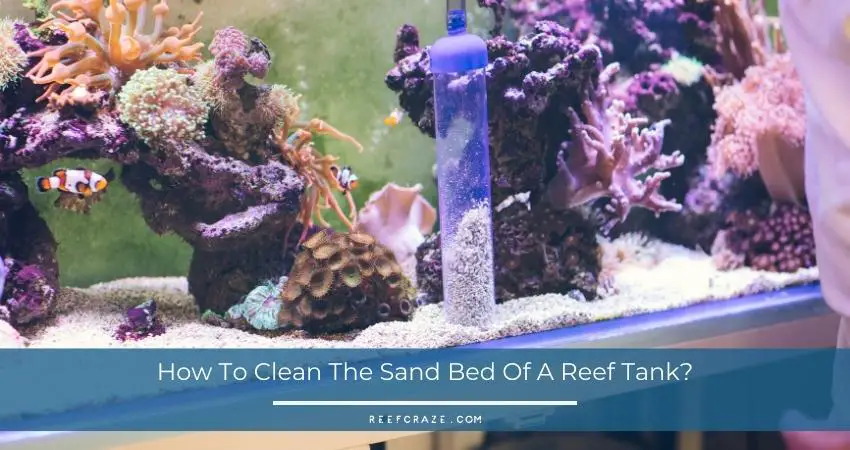
Why Should You Clean The Reef Tank Sand?
The most apparent reason is that it gets dirty. There are only so many areas in the tank where the garbage is disposed of. The bulk of trash not collected by skimmers can float around the tank, which may look very unattractive. The environment of the tank may also get inhabitable.
The sand will appear far nicer, and the fish will also benefit from your efforts if you keep the sand bed clean. Waste that is not properly disposed of may harm the water quality and the fish’s safety. As a result, be sure to clean the sand bed regularly.
How To Clean The Sand Bed Of A Reef Tank Manually?
To prevent waste from being stuck there, the sand bed of your reef tank must be cleaned frequently. You may face the risk of altering the water’s chemistry and creating a disastrous situation in the tank if you expose too much waste at once. Spend some time cleaning the tank if it’s old and has a deep, mistreated sand bed.
Here are some manual ways you can apply to clean the sand bed of your reef tank:
1. Siphoning The Sand During Water Replacement
If the sand bed is unclean and wasn’t cleaned in a long time, you can use a siphon vacuum for this technique. Aquarium siphons are available in many sizes and with a variety of features to aid in starting the siphon.
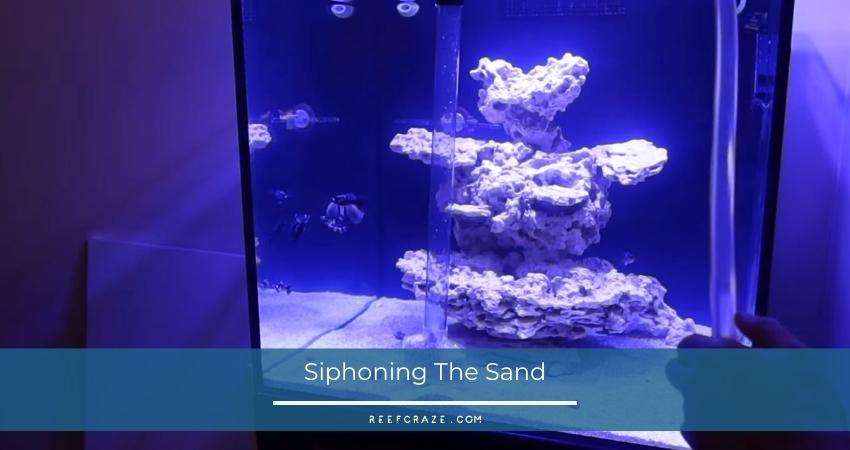
A flexible hose tube that links to a rigid plastic tube is frequently used in aquarium siphons. The tubing and hose are used to generate a siphon that draws water from the tank. It is better to use this procedure while doing a routine water change.
Based on the siphoning equipment you got, start the siphon. You may begin cleaning the sand after the water is drained out of the tube without any air flowing through. Small quantities of sand should be able to be drawn into the tube by the siphon’s sufficient vacuum. You should notice sand being drawn through into the siphon pipe and some of it swirling up inside the tube if you lightly push it into the sand. The sand in the tube will switch out if you move the siphon from the bed and return it to the sand bed.
In the places you wish to clean, slowly move this way up and down over the tank’s sand bed. Be patient and attempt to fill the tube with as much trash as you can. Keep going with your water replacement to the tank until you have cleared the spots you wanted to clean.
This approach is quite effective and may be used as required or even with each water change. It helps to prevent disturbing populations of healthy bacteria and other organisms that inhabit the sand substrate. If your bed is unclean, you may have to repeat the steps a few more times to get it in the right place.
2. Using A Vacuum To Siphon Sand Into A Filter Sock
This procedure is pretty similar to the last one. Take almost the same measures as the last technique, but rather than remove the water to a different pot, drain it into a filtration sock in the basement while your reverse pumps are working.
If you’ve got a vast area to clean, this approach will enable you to siphon continually. When you’re done, just stop the siphon and detach the filter sock to clean up. This is an excellent way to get a lot more cleanups done quickly.
However, be cautious if the sand bed is particularly deep and you haven’t washed it in a long time. Dissolved organic waste can get beyond the filter sock and reach the water column.
3. Stirring The Sand To Make It Clean
If done regularly, stirring your sand bed can be an excellent method to keep it clean. Just use an object to gently agitate the sand bed for this approach. You can put tongs into your sand bed and swirl the sand lightly. If the sand bed is pretty clean, this is a nice option to utilize once a week. Doing so regularly will make the sand bed fresh. After using this procedure, you may notice some cloudiness in the water, but it normally disappears and resolves in less than an hour.
This isn’t an approach to employ if you had a deep unclean sand bed since it would allow waste to enter the water column easily. This procedure usually works as a maintenance operation on a clean, well-maintained sand bed.
4. Adding Micro Bubble Scrubbing
You have to add microbubbles here to clean your sand bed. You can make microbubbles by shifting your recirculating pump up until it is slightly open to the air or by keeping the level of water in the sump just a little bit low to allow the return pumps to make microbubbles.
Once you start stirring the sand, the microbubbles will stick to waste inside the water column and keep moving to the top of the aquarium. Then it will go down into the sump, where filtration socks or the siphon tube can clean it up. This method makes the water clean quickly and can help get rid of more waste before it begins to get trapped on the bed after being stirred. Make sure to replace the socks and drain the skimmer.
5. Turkey Baster
Another easy way to clean the sand bed is by using a turkey baster. Just use a regular kitchen turkey baster for blowing water into your sand bed. The force used depends on how firmly you press the baster. A turkey baster may be combined with other tools to access areas in the tank that are hard to get to.

Coral feeders are another sort of baster you might use. They are lengthier than a turkey baster and can assist you in keeping your hands out of the tank. You can also use a turkey baster to blow trash and other debris away from the live rocks.
6. Replacing The Sand
You can also manually remove, rinse, and replace tank sand. You may also refill old sand instead of washing it. Because of the potential for waste contained in a deep sand bed to be released into the water column, this might not be the best course of action if you’ve got a deep old sand bed.
This approach entails physically removing sand from the tank, replacing it with fresh sand, or washing it and refilling it. Use this technique in waves to protect healthy bacteria and microbes in your sand bed.
First, get a scoop to remove the sand from the tank. Next, stop all tank flow to avoid waste from stirring up and clouding the aquarium. Put aquarium sand in a container. 5-gallon buckets would work nicely here.
Once you’ve removed enough sand from the tank, reinstall it or rinse it. If you’re placing fresh sand in the tank, wash it a few times to reduce cloudiness. Slowly add additional sand towards the tank’s bottom to avoid clouding the water.
If you want to clean the tank’s sand, put it in a bucket and take it outdoors. To rinse the sand, fill half the bucket. Mix the sand using your hand after adding 3/4th of the bucket’s water. After stirring, empty the bucket.
Repeat until the clear water appears. You may have to repeat the steps depending on how filthy your sand is. When the sand is clean, carefully set it back inside the tank. This cleans the sand but removes both healthy and harm. This is an excellent way to move or reuse sand.
How To Clean The Sand Bed Of A Reef Tank Naturally?
For natural methods to work, cleaning crews like Starfish, Babylon snails, and gobies are needed to clean or stir up the sand. Here are some methods you can follow to clean the sand bed of your reef tank naturally:
1. Starfish
For your reef tank, Starfish is a fantastic alternative. These Starfish are calm, simple to identify by guests, and excellent members of the cleaning crew. These Starfish like digging burrows in the sand and carry a large amount of sand when they emerge from the burrows.
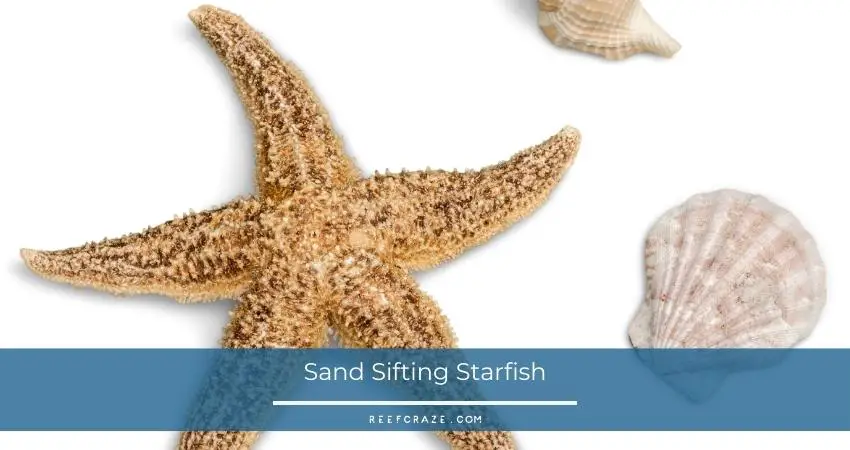
Although they don’t clean the sand, going inside and out of it keeps it aerated and churned up to prevent the trash from settling in. They contribute well to the cleaning team since they eat aquarium trash. Starfish also serve as a tank’s early alert system when anything goes wrong. Changes in the chemistry of the water are often quite intolerable to Starfish. Most of the time, sand sifting starfish spend in or around the sand bed.
If anything occurs or the Starfish becomes anxious, you could see it moving up the tank glass like it’s attempting to get out. The Starfish may serve as a warning for you to examine the settings before anything goes wrong and a tank crash occurs.
Read Next: Best Reef-Safe Starfish
2. Sand Sifting Gobies
A fantastic method for maintaining the cleanliness of a reef tank’s sand substrate is to use sand sifting gobies. Sand-sifting Gobies come in a wide variety of varieties, and many of them perform well and make excellent tank companions.
Most Sand Sifters get along well with other fishes in the tank, although they might be aggressive with other fish of the same species. Algae, pods, trash, and other items caught in the sand are among the things that sand-sifting Gobies consume. They achieve this by sifting the edible components out of a mouthful of sand. They diligently clean the bed throughout the tank while doing this the whole day long. They usually spend their days digging in the sand while hiding beneath rocks.
In the reef tank, certain Sand-sifting Gobies may mate up with pistol shrimp, resulting in a very interesting symbiotic interaction. Sleeper Gobies are the finest Gobies for sifting sand.
3. Nassarius Snails
Nassarius snails are superb scavengers and make good cleaning crew workers. They make calm tankmates and are widely available for purchase. They enjoy digging in the sand of the tank. These snails will burrow inside the sand and lift their suction pipe slightly above the sand’s surface to detect food around.
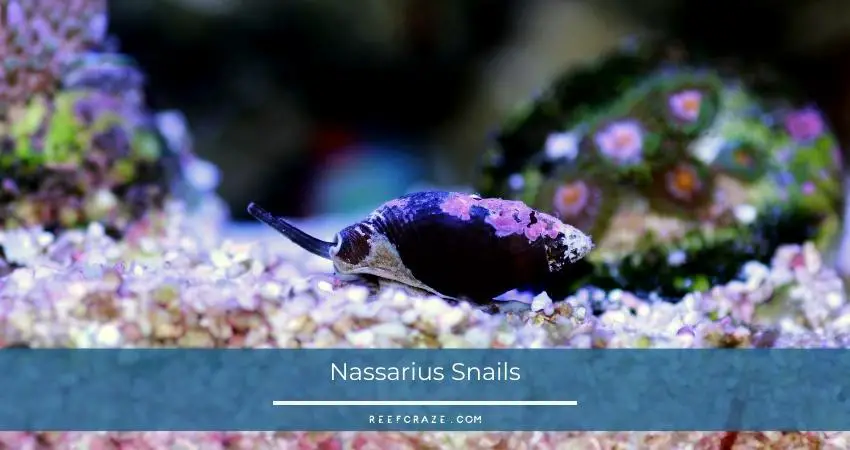
When they sense or smell food approaching, they emerge from the sand to consume it. This continual burrowing and coming up keeps the sand clean and oxygenated. If you want to maintain the sand bed clean using the Nassarius snail, you’ll need a lot of these guys.
4. Babylon Snail
Sometimes the name “Tiger Nassarius snail” is used to describe Babylon snails. However, while not being Nassarius snails, they exhibit similar behaviors to those of the snails. They live inside the sand bed and devour garbage.
Most of the time, these snails are awake at night and are actively working. These snails have light cream coloring with black dots or stripes, giving them a fairly unique appearance. They are attractive snails that move quickly around the aquarium. Compared to typical Nassarius snails, which are around 3 inches long, these snails may grow to be considerably larger.
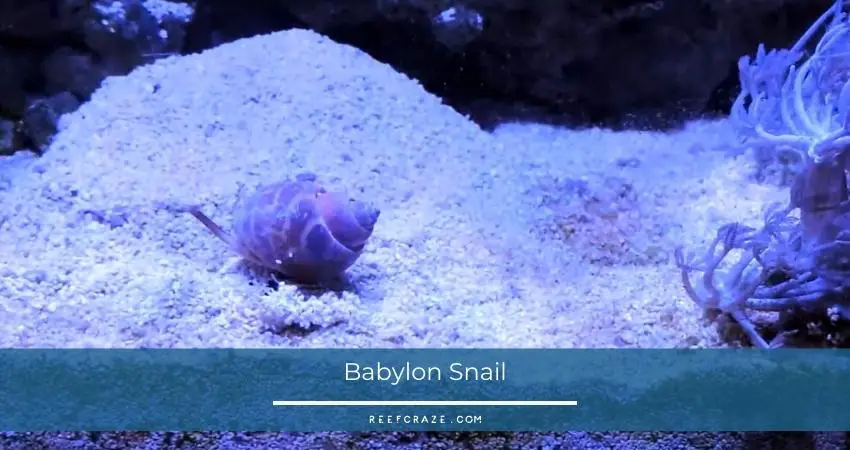
These snails roll over the sand substrate and maintain it tidy well because of their greater size. There are rumors that these snails can consume other snails and shells. Therefore, if you’ve got these other species in the tank, you should proceed with care.
5. Cerith Snail
Cerith snails are wonderful members to have on a team that cleans a reef tank. These snails get a shell that seems to be spiraled longer. Cerith snails are quite effective at clearing away the garbage and algae that have accumulated across the reef tank.
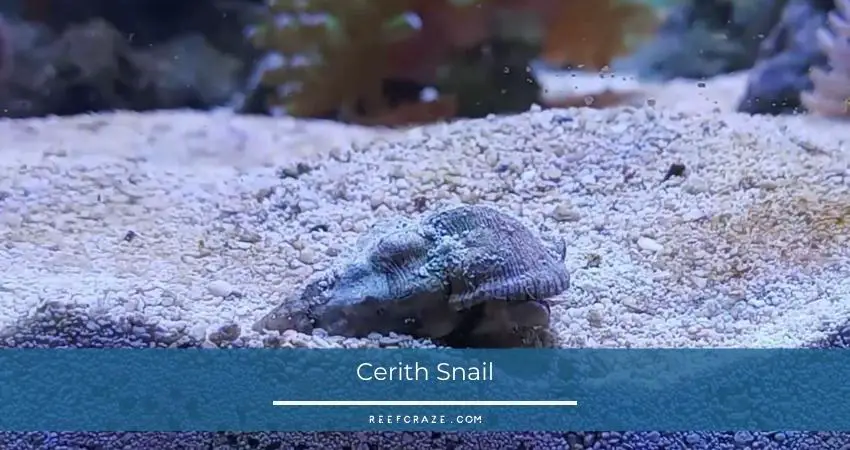
Cerith snails are low maintenance and won’t bother any of the other occupants in their reef aquarium. Since of their tiny size, you might need quite a few of these snails for the sand to remain clean. However, because they burrow inside the sand bed, they do contribute to the process of maintaining the sand fresh.
6. Fighting Conch
The Fighting Conch is a different type of waste consumer that burrows into the sand to maintain the sand bed oxygenated and clean. Its appearance is similar to other cleaner snails on this list. The term “Fighting Conch” comes from the aggressive violence that males of the species may exhibit against one another when they invade the domain of one another.
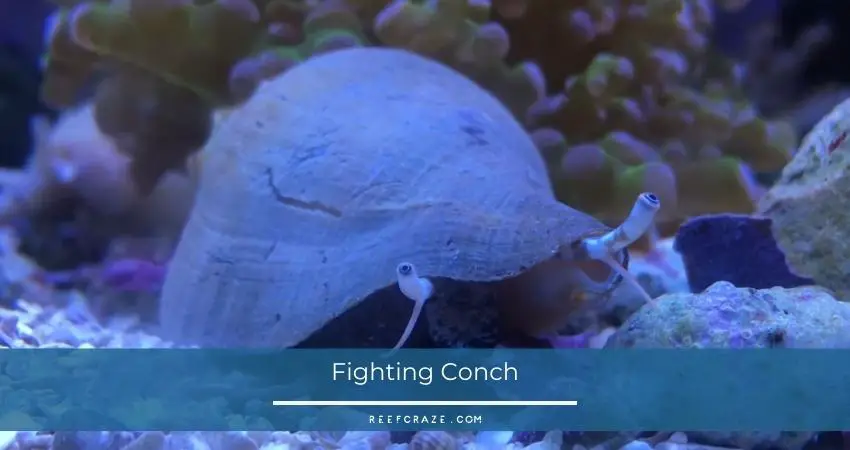
Hence, keeping many Fighting Conches in an aquarium that is bigger than necessary is recommended. Male Fighting Conchs could get into a battle with one another, but they won’t bother anybody else in the tank.
7. Hermit Crabs
Hermit Crabs are an absolute need for anybody who keeps reef aquariums as a hobby. There is a wide variety of them, and you can get your hands on them at most fish markets. Hermit Crabs are exceptional scavengers and will look for and eliminate garbage, algae, and food that has not been consumed in the tank.
Most hermit crabs do not dig burrows in the sand but instead drag their shells through the sand bed and pick through it for prey. This activity contributes to maintaining small aeration in the sand and a turning over of the very healthy level.
8. Sand Sifting Sea Cucumbers
Sea cucumbers are intriguing organisms that also do an excellent job of maintaining the cleanliness of the aquarium and the sand substrate. Sand and feces are both consumed by sea cucumbers and subsequently expelled in an uncontaminated form via the other end of the animal.
Although they may be an interesting addition to the tank and help keep the water clean, you have to take good care of them. The majority of species of cucumbers have poisons, which may be produced when the cucumbers are under tension or when they pass away.
These poisons have the potential to cause the death of your fish as well as the corals. If the Cucumber discharges its poison, you may get relief by using a reliable protein skimmer, new carbon, and frequent water changes. Sea cucumbers may get rather large, so you’ll need a tank that’s big enough to hold them all.
Frequently Asked Questions
How can you clean the reef tank sand before use?
The simplest technique to clear reef tank sand before usage is to fill huge five to ten-gallon buckets with the substrate. The tank sand should then be rinsed until the water comes clean. The unclean water may take a while to disperse based on the sand. But it will be clean after some time.
How to get rid of a sand cloud in the tank?
Sand clouds irritate any owner because they turn their once-pristine fish tank appear less than appealing. The simplest method to prevent a sand fog is to prevent it from the beginning place. Before adding sand to the reef tank, make sure you’ve replaced it with clean water.
Will cloudy sand water hurt my fish?
The fish will be alright as long they are not gasping in the water. Feed a modest amount every alternate day until the haziness is gone from the water. Check that the filter is working correctly, but don’t clean it if it is not working properly. The easiest method to overcome cloudy water would be to completely avoid it.
How can you get algae out of a sand bed?
When you replace the water in your tank, choose a gravel vacuum to suck out the old water and clear the sand bed. This will result in the removal of debris and uneaten food, as well as the turning over of the sand, which will bury algae and other creatures that produce their food via photosynthesis.
Should I vacuum the sand bed of the reef tank?
Vacuuming the sand bed of a reef aquarium consistently as part of the weekly maintenance is a fantastic technique to maintain its clean appearance. Even when you replace the water in your tank often, it won’t be possible to get rid of all of the trash. Yet this approach can be very helpful if you do it regularly.
Final Words
When you have the appropriate maintenance routines in place and a few aquatic volunteers to do their part, it is not difficult to maintain the cleanliness of your sand bed. Your aquarium will look much better if it has a fresh sand bed.
Just ensure that you take care of the sand bed regularly and take all measures when doing so. The filtration is one of the most important things to remember to switch off briefly and then turn back on after your reef tank sand has been cleaned. Your fish will appreciate the clean sand substrate and water.

